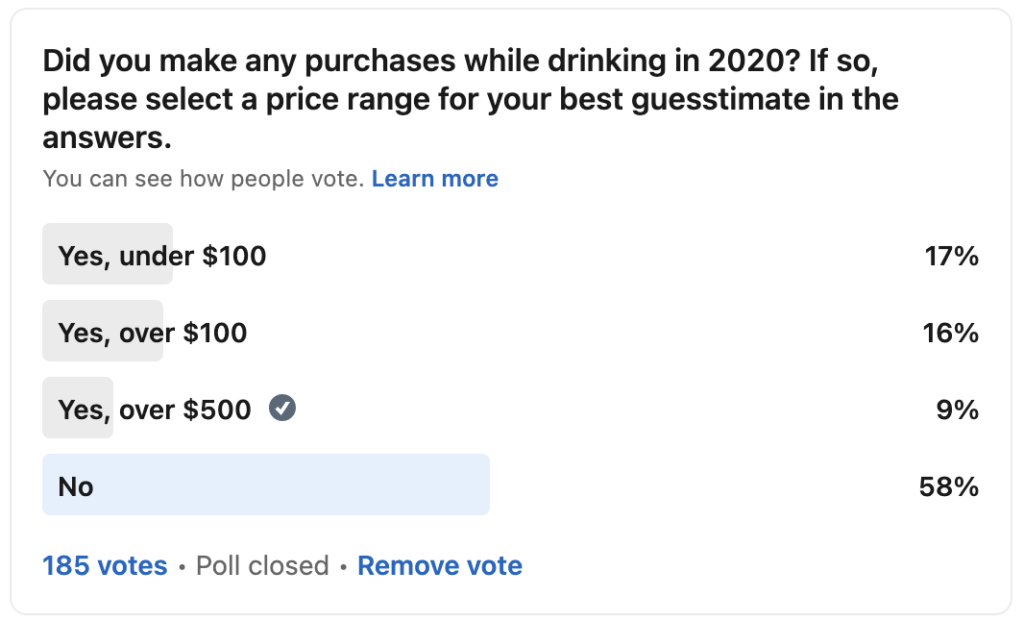Click, click, buy: e-commerce trends driven by DTC, mobile, social
 2021 e-commerce trends reflect a society that's forever changed. Brands must focus on DTC, mobile, social as a search tool, and data.
2021 e-commerce trends reflect a society that's forever changed. Brands must focus on DTC, mobile, social as a search tool, and data.
My first drunk shopping article was published on January 21, 2020 – so, in The Before Times. If, like me, you might be the sort who uses dark humor as a coping mechanism, then you can appreciate what a bright spot the thought of writing the 2020 statistics regarding shopping under the influence was.
$45 BILLION for e-commerce in 2019? I could only imagine what the 2020 data would show – was there even a word for that sort of massive growth?
2019: $45 BILLION for e-commerce. I am all powerful, omnipotent, unconquerable.
2020: Hold my beer.
Except, it seems, y’all are reticent to tell the darn truth.
Finder, the amazing people who thought up this excellent survey in the first place, said the following in their article with the long-awaited 2020 drunk shopping stats: “The percentage of Americans that admitted to buying under the influence has slowly decreased each year from 26.4% in 2019 to 21.4% in our most recent survey.”
The woozy shopper spent an average of $423.73 on drunk purchases in 2020, compared to $768.58 in 2019. Supposedly, Americans spent $21.6 billion while shopping under the influence in 2020, down 51.80% from 2019’s $44.9 billion.
We’ve all been on enough Zooms, Teams, Skypes, Google Hangouts, all-hands, and email threads to know that day drinking was all the rage for at least some months during 2020.

More than 10 people messaged me to say they were worried about voting on it, but had stories to tell.
First, while researching for my initial drunk shopping article, a childhood dream came true: They really do sell *just* the marshmallows from Lucky Charms.
The 2020 post went live January 21, 2020 – please note the purchase date of possibly the most shameful item I’ve ever paid for:

My husband and I made a pact that we’d forget this existed – a pandemic with two adults working from home, two teens going to school from home, and a bag of sugar doesn’t equate to being the best of humans; rather it equates to the opposite.
The Lucky Charms Purchase-That-Must-Not-Be-Named was nothing compared to the day my hubby asked me if I was on mute while on a call… so I could explain the “forest from the internet” that appeared to be on our porch. In my defense, our Internet Forest ™ looks amazing:

 2021 e-commerce trends reflect a society that's forever changed. Brands must focus on DTC, mobile, social as a search tool, and data.
2021 e-commerce trends reflect a society that's forever changed. Brands must focus on DTC, mobile, social as a search tool, and data.
The generation that’s always forgotten quietly spent the most while shopping under the influence: Generation X spent an average of $521.57 versus $797.49 in 2019. Millennials spent an average of $475.75, and Boomers lollygagged into last place, spending $274.62 while drunk shopping.
Despite the total dollars spent while drunk shopping (supposedly) declining year over year, tipsy consumers are still throwing around big bucks after kicking back a few of their alcoholic faves.
It’s typically with Amazon, and it’s no wonder why: the e-commerce giant serves up a potent cocktail of convenience, making purchases easy to accomplish.
Simplicity makes it easier for the sotted to buy while under the influence, so retailers must be mindful of the journey consumers are taking while on their site – and how they get there.
 Social platforms provide brands with a unique window to meet shoppers where they are most engaged. Find out how brands can build a profitable social commerce strategy.
Social platforms provide brands with a unique window to meet shoppers where they are most engaged. Find out how brands can build a profitable social commerce strategy.
This Reddit thread offers side-splitting recounts of the best drunk shopping purchases. Here’s a few:
The drunk purchases must stop pic.twitter.com/MPIn2iPt1X
— marissa dallow (@marissadallow) July 4, 2021
According to @Finder, drunk shoppers are spending an average of $423.73 on drunk purchases a year.
Recently, my wife and I unknowingly both drunk shopped. One of us is well under the national average and one of us has obliterated it… pic.twitter.com/XTiEA7GaUn
— Brian Murphy (@Brian_Murphy_) July 6, 2021
Let's all take a minute to appreciate this drunk Amazon purchase 🙌🏽 pic.twitter.com/N8L09HKD7e
— Morgan Stamper (@MorganLStamper) July 24, 2016
Accidentally bought my toad 100 top hats instead of one while I was drunk online shopping… from funny